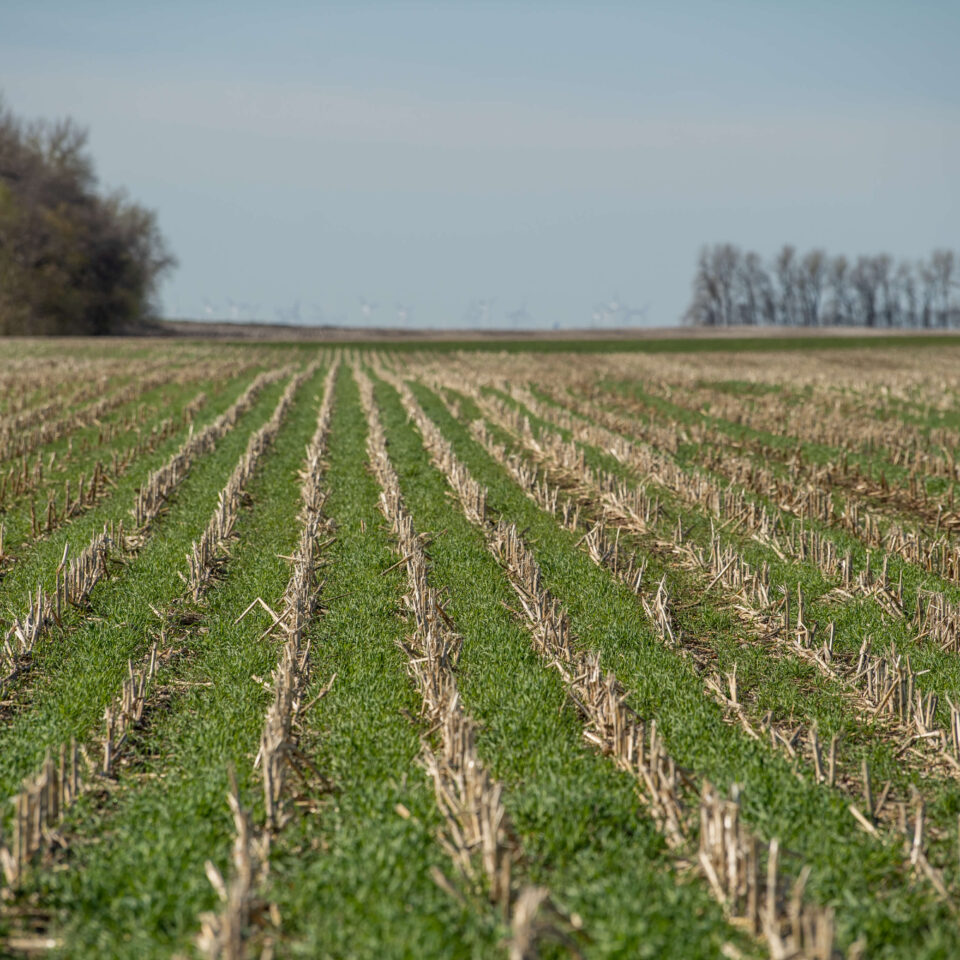
Some of the key issues we face today in our cropping systems can help be managed with the implementation of cover crops. Major issues such as nitrogen loss, compaction or the development of a plow pan, soil health, and wind and water erosion are all very important to manage for both economic and environmental reasons. Cover crops are typically planted to grow when the field would otherwise be left bare, such a following wheat harvest in July or through the winter months. Some producers utilize cover crops in susceptible areas of a field such as a sand knoll or throughout an entire field.
There are numerous opportunities each year to include cover crops into your crop rotation. Ideally you want to ensure that soil is covered with at least 30% residue 100% of the time. This can be through the actual crop, crop residue or a cover crop.
Establishment
There are a number of methods to seeding cover crops. These include broadcasting (with or without incorporation), drilling, aerial seeding, seeding with manure and frost seeding. Which method you use is determined by what equipment you have available and what cover crop is being grown. Other factors to consider are ensuring there is adequate soil moisture for germination, proper seeding depth and seed to soil contact and even distribution of the seed throughout the field.
Planting Green
Some growers have experimented with planting their cash crop directly into a growing cover crop. The logic behind this is to for the cover crop to provide weed control for the crop during the critical weed-free period of that crop. Recent research has suggested that even before a crop emerges, the seedling can sense if another species of plant is growing near them, and will adjust their morphology to respond to that competing plant, ultimately affecting yield. Because of this new research, ensure that the cover crop is terminated by the time the seed has germinated, prior to emergence.
Single Species vs Mixed Species
| Single Species | Mixed Species |
|
|
Termination
It is very important to have a plan on how your cover crop will eventually be killed off. Some cover crops grow very quickly and can get away from a grower if they are not killed off in time. There are a number of methods that can be used to terminate a cover crop. They tend to fall under 3 main categories including mechanical (tillage, mowing, etc.), chemical (herbicides), and winter kill. What method will be needed will depend on the species being grown, and the equipment you have available to use.
Three Common Practices for our Major Crops
| Cover Crop | Establishment | Benefits | Risks |
| Red Clover after Wheat |
|
|
|
| Winter Wheat after Soybeans |
|
|
|
| Cereal Rye after Corn |
|
|
|
Benefits of Cover Crops
Source of Nitrogen
Legume plants are the only type of crop that can fixate nitrogen from the atmosphere into a plant available form. After the cover crop is terminated, much of this nitrogen will eventually become available for uptake in following crops. This is especially useful following wheat harvest when going into a corn crop the next year,
reducing the amount of N that will need to be applied to the corn next spring.
Nitrogen Scavenger
Growing roots of all crops take up soil nitrate from fertilizer and mineralization from soil organic matter. Having a cover crop present reduces the amount of N that would potentially leach out of the soil profile, and saving some of it for the following crops. The rest of the N that is scavenged will help to build organic matter content in the soil. This also protects the nitrates from leaching into water sources as well.
Soil Builder
Cover crops help build soil organic matter by adding carbon to the soil. Fibrous root systems entangle themselves with soil particles to help stabilize soil aggregates. Deep roots improve permeability, leading to increased water infiltration and aeration. Large taproots can also penetrate compacted soil layers, providing pores for future root growth. Cover crops also provide additional food for soil fauna such as earthworms.
Erosion Control
Cover crops were first and are most widely used to reduce erosion from wind and water. Living roots help hold the soil together, while the above ground portion protects from wind blowing topsoil away, and from runoff caused by rain or flooding.
Weed Suppression
Some cover crops are exceptional at their ability to fight and suppress weeds. This can be due to quick aggressive growth, allelopathic affects, etc.
Topsoil/Subsoil Loosener
Reducing compaction helps the overall structure of soil, leading to better root growth of crops. Certain cover crops, based on their rooting systems, are better able to reduce compaction in topsoil or lower down in the subsoil of the profile. Generally speaking, plants with fibrous root systems are better for loosening topsoil and plants with larger taproots are better for loosening deeper subsoils.
Grazing Value
Some cover crops can also provide livestock producers with extra opportunities for grazing or forages.
Below is a tool that can be used to assist in choosing a cover crop. This should be only used as a general guideline as different species can develop and grow differently based on growing conditions. Other variables such as seeding and termination must work with your cropping system once a specific cover crop or mix is chosen.

Featured Image: Minnesota Corn Growers Association
Additional Sources: Midwest Cover Crops Field Guide (2nd Edition), Ohio’s Country Journal, No-Till Veggies